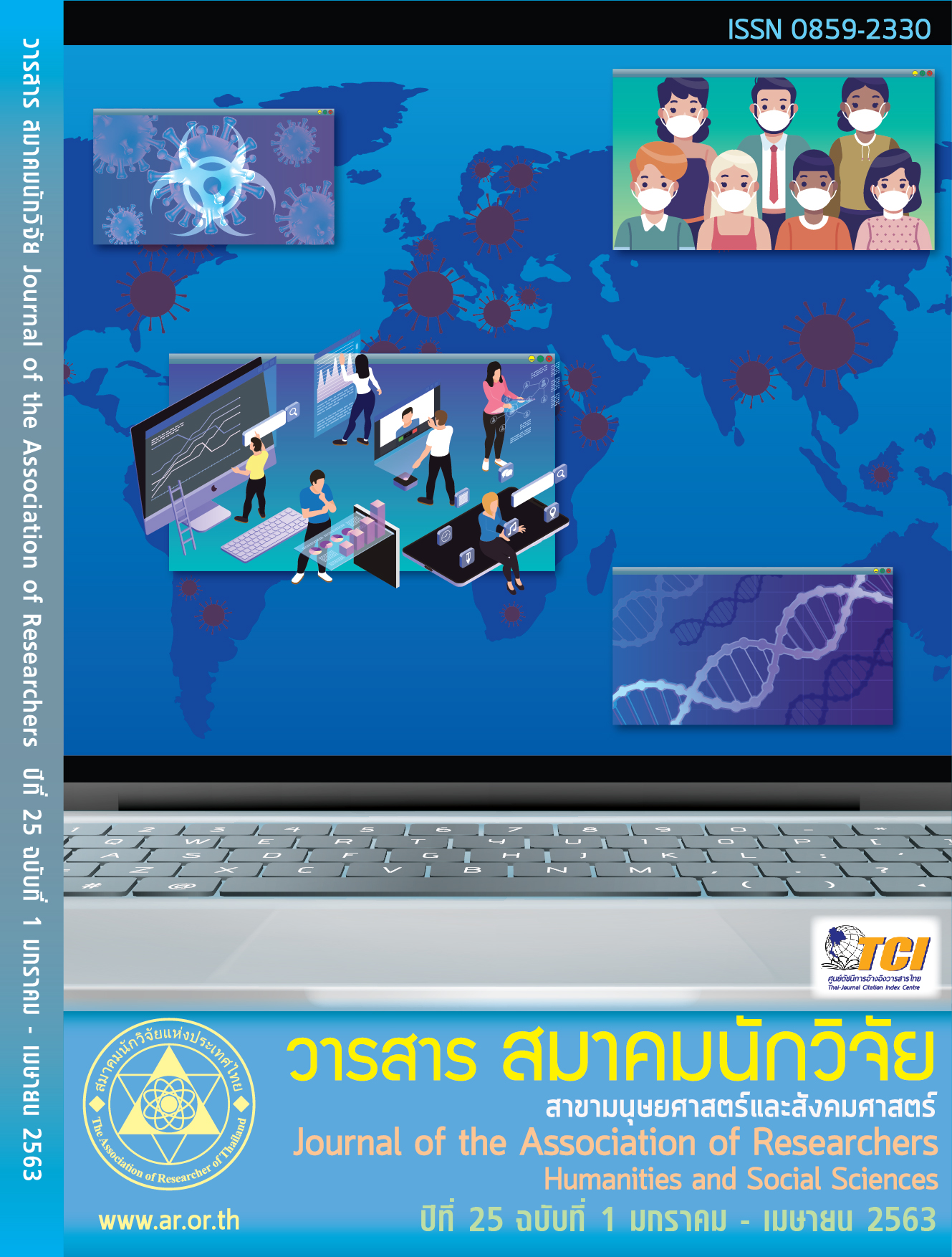The Causal Relationship Model of Dynamic leadership and Competitive strategies that affecting operational efficiency of Community Enterprise Leader in Sakhonnakhon province.
Main Article Content
Abstract
The purpose of this research were 1) to study the relationship of dynamic leadership, competitive strategies and operational efficiency of work and 2) to analysis the causal relationship model of dynamic leadership and competitive strategies that affecting of community enterprise leader in Sakhonnakhon. The sample consisted 400 community enterprise entrepreneurs in Sakhonnakhon province. The research tool was questionnaires and analyze data by LISREL to measure the relationship of variables.
The results found 1) result to study the relationship of dynamic leadership, competitive strategies and operation efficiency of work that found all variable are related to each other and 2) analysis the causal relationship model of dynamic leadership and competitive strategies that affecting of community enterprise leader in Sakhonnakhon that the causal relationship model is fit to empirical data (x2=23.20, x2/ dƒ = 0.682, P-value = 0.919, RMSEA = .000, GFI=0.970, CFI= 0.980, AGFI= 0.880, NFI=0.970). the dynamic leadership have direct and indirect effect on competitive strategies to an operational efficiency of community enterprise leader in Sakhonnakhon. The competitive strategies have direct effect on operational efficiency of community enterprise leader in Sakhonnakhon.
Article Details
บทความที่ปรากฏในวารสารนี้ เป็นความรับผิดชอบของผู้เขียน ซึ่งสมาคมนักวิจัยไม่จำเป็นต้องเห็นด้วยเสมอไป การนำเสนอผลงานวิจัยและบทความในวารสารนี้ไปเผยแพร่สามารถกระทำได้ โดยระบุแหล่งอ้างอิงจาก "วารสารสมาคมนักวิจัย"
References
กาญจนา ดำนิล. (2557). รูปแบบการพัฒนาภาวะผู้นำการเปลี่ยนแปลงของผู้บริหารสถานศึกษา สังกัดสำนักงานคณะกรรมการการศึกษาขั้นพื้นฐาน. วารสารวิจัยและพัฒนาวไลยอลงกรณ์ในพระบรมราชูปถัมภ์, 9(2), 296-308.
จักเรศ เมตตะธำรงค์, วรรณิดา สารีคำ และปาณิสรา ประจุดทะศรี. (2561). องค์ประกอบปัจจัยในการดำเนินธุรกิจของผู้ประกอบการวิสาหกิจชุมชนในเขตภาคตะวันออกเฉียงเหนือตอนบน. วารสารการจัดการสมัยใหม่, 16(2), 29-42. [in Thai].
ชมภูนุท จั่นนุ้ย และ พินิจ ลาภธนานนท์. (2562). ความสำเร็จของวิสาหกิจชุมชนบนพื้นฐานความอยู่รอดและพอเพียง. วารสารศิลปศาสตร์ปริทัศน์, 14(1),67-78.
ชัยเสฎฐ์ พรหมศรี. (2557). ภาวะผู้นำร่วมสมัย. กรุงเทพมหานคร: ปัญญาชน
ชุติมันต์ สะสอง และ บุญฑวรรณ วิงวอน. (2559). ความร่วมมือของผู้มีส่วนได้ส่วนเสียและแผนธุรกิจที่มีบทบาทในการขับเคลื่อนกลุ่มวิสาหกิจหนึ่งตำบลหนึ่งผลิตภัณฑ์ (OTOP) ให้มีความได้เปรียบในการแข่งขันอย่างยั่งยืน. วารสารมหาวิทยาลัยนครพนม, 6(1), 124-133.
ชุมพล นุชผ่อง, สมอาจ วงษ์ขมทอง, จันทร์จิรา วงษ์ขมทอง, และเนตรชนก ศรีทุมมา. (2560). โมเดลความสัมพันธ์เชิงโครงสร้างระหว่างภาวะผู้นําากลยุทธ์และกลยุทธ์ด้านการเงินของโรงพยาบาลที่ส่งผลต่อผลการดําาเนินงานด้านการเงินของโรงพยาบาลชุมชน. วารสารวิทยาลัยพยาบาลพระปกเกล้า จันทบุรี, 28(2), 13-28.
ธงชัย วงศ์พาบุ, สุภาพรรณ พาบุ และสุภารดี สวนโสกเชือก. (2559). การจัดการความรู้เพื่อเสริมสร้างศักยภาพและความสามารถทางการแข่งขันของวิสาหกิจชุมชนในจังหวัดสุรินทร์. วารสาร มทร.อีสาน ฉบับมนุษยศาสตร์และสังคมศาสตร์, 3(2), 55-70.
ธนัณชัย สิงห์มาตย์. (2559). การพัฒนาผลิตภัณฑ์เพื่อเพิ่มขีดความสามารถในการแข่งขันของวิสาหกิจชุมชนในจังหวัดมหาสารคาม. ว.มรม. (มนุษยศาสตร์และสังคมศาสตร์), 10(2), 105-115.
นันธิดา จันทร์ศิริ. (2560). ภาวะผู้นำการเปลี่ยนแปลงในการบริหารการเปลี่ยนแปลงเพื่อสร้างสรรค์นวัตกรรมภายในองค์กร. สารอาศรมวัฒนธรรมวลัยลักษณ์, 17(1), 80-98.
มนูญ สอนเกิด. (2549). เศรษฐกิจพอเพียงกับวิสาหกิจชุมชนความต่างที่ทับซ้อนและต่อเนื่องเพื่อความเข้มแข็งของเศรษฐกิจฐานราก. กรุงเทพมหานคร: สำนักส่งเสริมวิสาหกิจชุมชน.
วิทยา ด่านธำรงกูล. (2549). หัวใจการบริการสู่ความสำเร็จ. กรุงเทพมหานคร: ซีเอ็ดยูเคชั่น.
วิรัช สงวนวงศ์วาน. (2547). การจัดการและพฤติกรรมองค์การ. กรุงเทพมหานคร : เพียร์สัน เอ็ดดู เคชั่นอินโดไซน่า จํากัด.
วีราวรรณ มารังกูร และ ปรีชญา ชุมศรี. (2550). การตลาดและการสร้างข้อได้เปรียบทางด้านการแข่งขันของผู้ประกอบการหัตถกรรม จังหวัดสงขลา. วารสารวิชาการและวิจัย มทร.พระนคร สาขาวิทยาศาสตร์และเทคโนโลยี, 1(2), 203-210
สุภาวดี วัฒนานิมิตกูล, กนกพรรณ บรมสุข, นพวรรณ จินะปริวัตอาภรณ์, สุวิมล ชื่นชม, หัทยา เยื่อแม้นพงศ์, น้ำฝน แย้มร่วมญาติ และ วิโรจน์ เจษฎาลักษณ์. (2560). การสร้างความได้เปรียบทางการแข่งขันของธุรกิจเบเกอรี่ : กรณีศึกษาเค้กโอ่ง ร้านอาตี๋โกปี๊ จังหวัดราชบุรี. Veridian E-Journal, Silpakorn University (Humanities, Social Sciences and arts), 10(1), 1477-1492.
References
Bollen, K. A. (1987). Structural Equations with Latent Variables. New York: Wiley.
Diamantopoulos, A., and Siguaw, A. D. (2000). Introducing LISREL : A guide for the uninitiated. London: Sage Publications.
Hair Jr, J. F., Hult, G. T. M., Ringle, C., and Sarstedt, M. (2013). A primer on partial least squares structural equation modeling (PLS-SEM). Sage Publications.
Hu, L. T., and Bentler, P. M. (1999). Cutoff criteria for Fit index in covariance structure Analysis: conventional criteria versus new alternations. Structural equation Modeling: A Multidisciplinary Journal, 6, 1-55.
Kim, J., and Mueller, C. W. (1978). Factor Analysis : Statistical Methods and Practical Issues. Beverley Hills: Sage Publidcation.
Porter, M. E. (2005). The Competitive Advantage Creating and Sustaining Superior Performance. New York: The Free Press.
Translated Thai References
Chunnui, C., and Lapthananon, P. (2019). Community enterprise success on the basis viability and sufficiency. Liberal Arts Review, 14(1),67-78. [in Thai].
Damnin, K. (2014). Model of change leadership development of school administrators Under the Office of the Basic Education Commission. VRU Research and Development Journal Humanities and Social Science, 9(2), 296-308. [in Thai].
Danthamrongkul, W. (2006). Service of heart to success. Bangkok: SE-ED Ucation. [in Thai].
Jansiri, N. (2017). Leadership in change management to create innovation in organization, Walailak Abode of Culture Journal, 17(1), 80-98. [in Thai].
Marangkul, W. and Chumsri, P. (2007). Marketing and competitive advantage for Handicraft enterpreneurs in Songkhla. RMUTP Research Journal Science & Technology, 1(2), 203-210. [in Thai].
Mettathamrong, J., Sareekham, W., and Prajudtasri, P. (2018). The elements factors in business operation of community enterprise entrepreneurs in the upper northeast. Modern Management Journal, 16(2), 29-42. [in Thai].
Nuchphong, C., Wongkhomthong, S., Wongkhomthong, J., and Sritoomma, N. (2017). The Structural Relationship Model among Strategic Leadership and Hospital Financial Strategy on Hospital Financial Performance at Community Hospitals. Journal of Phrapokklao Nursing College, 28(2), 13-28. [in Thai].
Pabu, T., Pabu, S., and Saunsokchaug, S. (2016). Knowledge management for potential and competitive community enterprises in Surin province. RMUTI JOURNAL Humanities and Social Sciences, 3(2), 55-70. [in Thai].
Promsri, C. (2014). Contemporary leadership. Bangkok: Panyachon. [in Thai].
Sanguanwongwan, W. (2004). Management and Organizational Behavior. Bangkok: Pearson Education Indochaina Limited. [in Thai].
Sasong, C., and Wingwon, B. (2016). Stakeholders’ collaboration and a business plan play a role in driving the OTOP enterprises group to sustainable competitive advantage, Nakhon Phanom University Journal, 6(1), 124-133. [in Thai].
Singmat, T. (2016). Product development to enhance the competitiveness of community enterprise in Maha Sarakham. RMU.J. (Humanities and Social Sciences). 10(2), 105-115. [in Thai].
Sornkuart, M. (2006). Sufficiency economy and community enterprises, overlapping and continuous differences for the strength of the foundation economy. Bangkok: Bureau of Agricultural Community Enterprise. [in Thai].
Wattananimitkul, S., Boromsuk, K., Jinapariwatarporn, N., Chuenchom, S., Yueamanpong, H., Yamruamyat, N., and Jadesadalug, V. (2017). Creating competitive advantage of business bakery: A case study of cake Aong Arteekhopee in Ratchaburi. Veridian E-Journal, Silpakorn University (Humanities, Social Sciences and arts), 10(1), 1477-1492. [in Thai].
Wongput, K. (1992). Leadership. Bangkok: Bangkok University. [in Thai].


